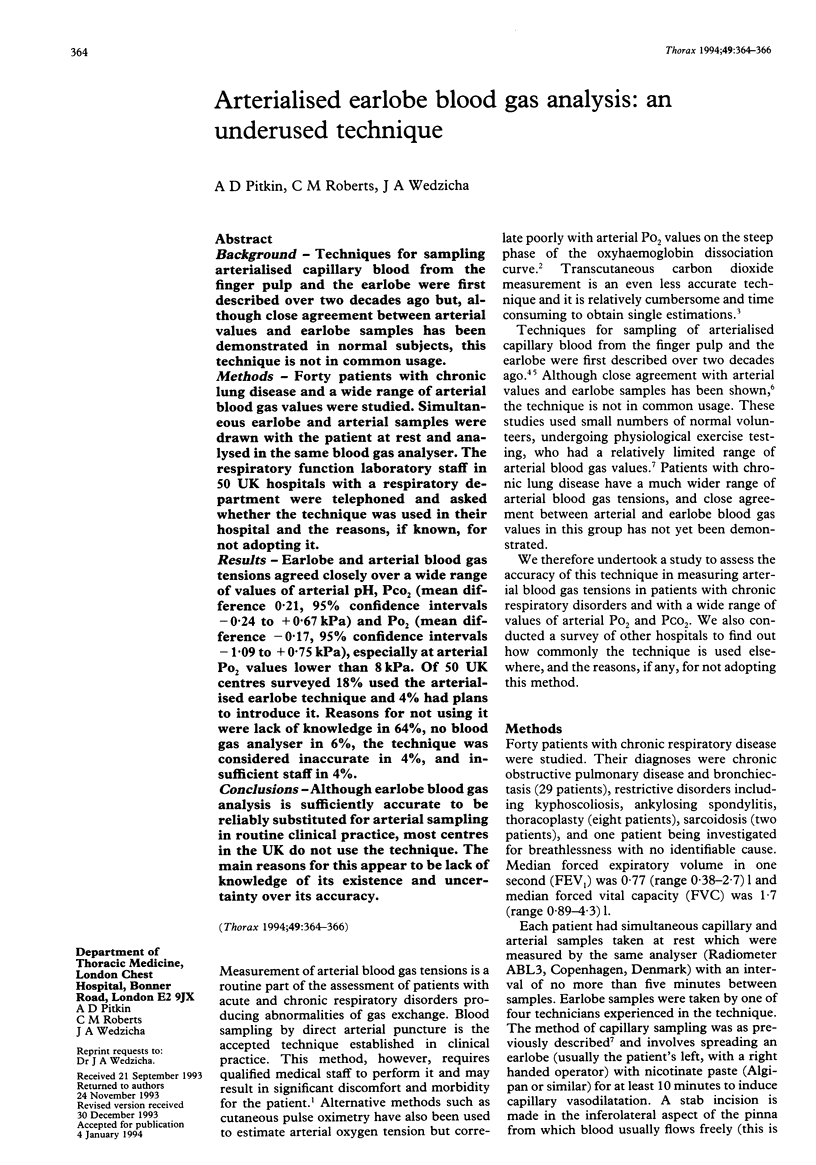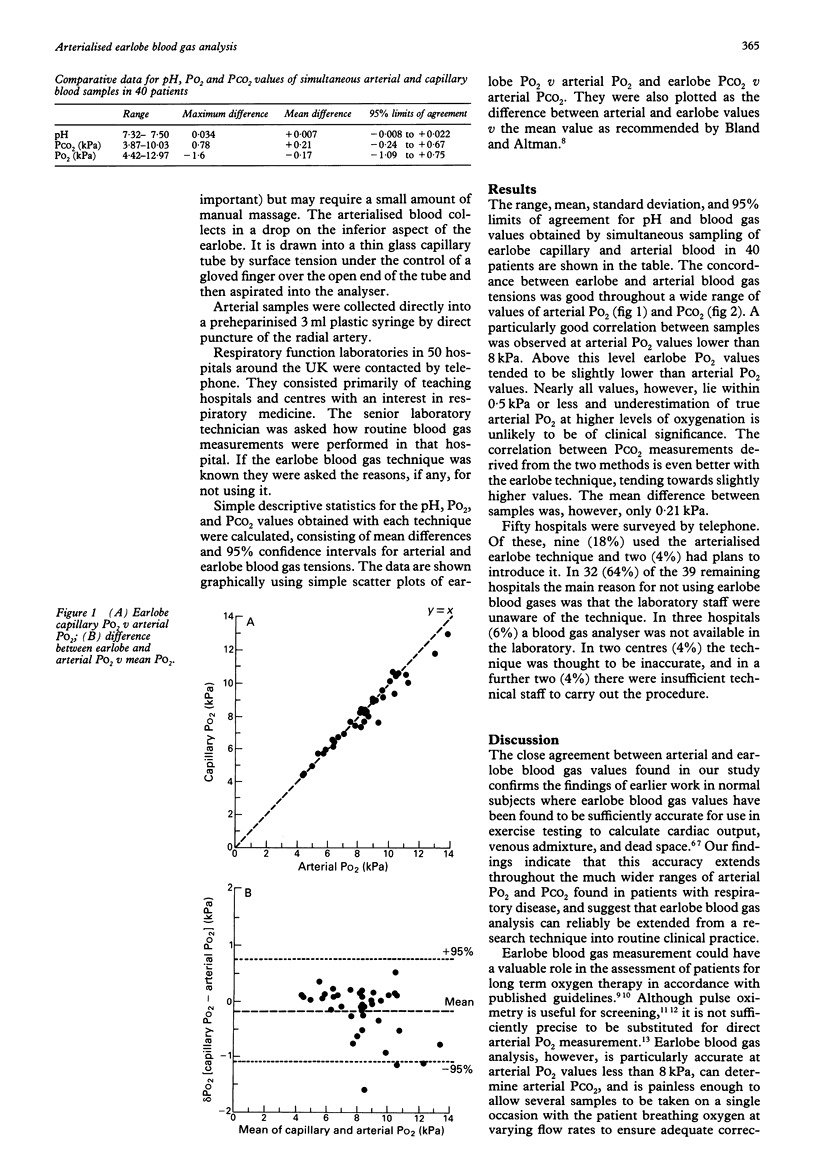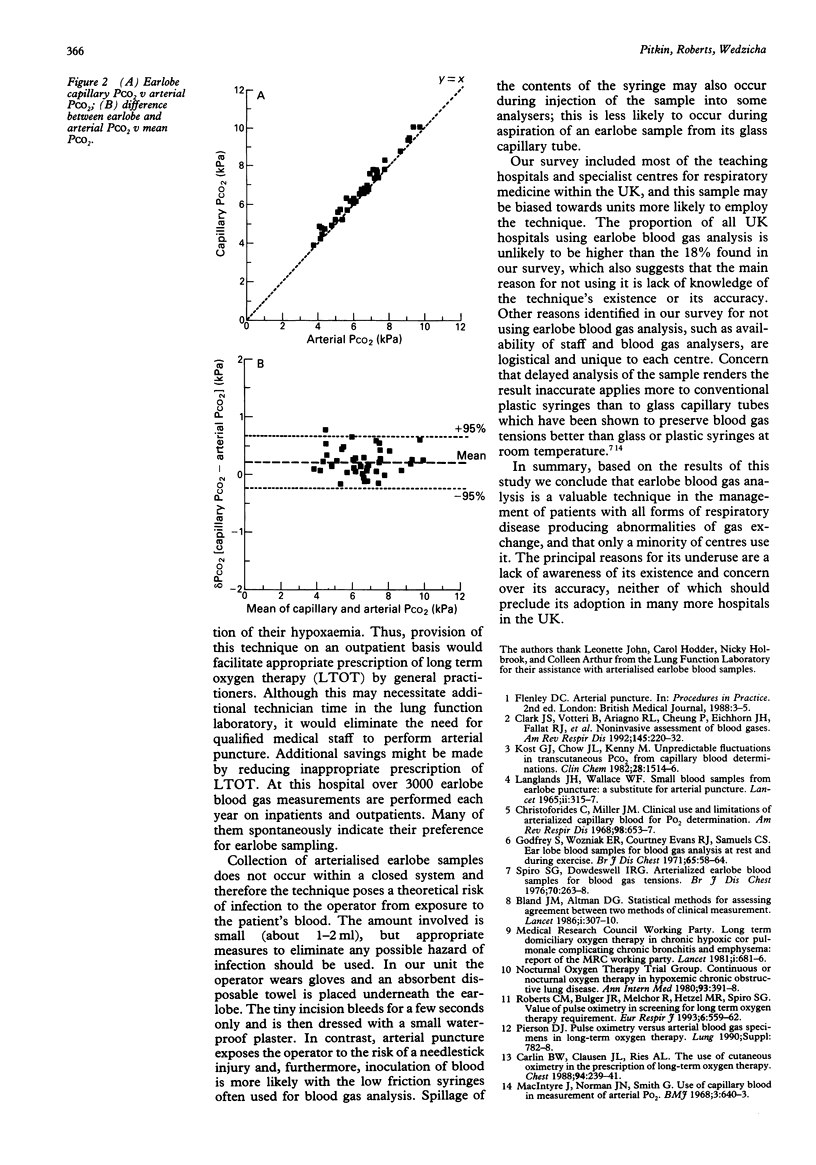Abstract
BACKGROUND--Techniques for sampling arterialised capillary blood from the finger pulp and the earlobe were first described over two decades ago but, although close agreement between arterial values and earlobe samples has been demonstrated in normal subjects, this technique is not in common usage. METHODS--Forty patients with chronic lung disease and a wide range of arterial blood gas values were studied. Simultaneous earlobe and arterial samples were drawn with the patient at rest and analysed in the same blood gas analyser. The respiratory function laboratory staff in 50 UK hospitals with a respiratory department were telephoned and asked whether the technique was used in their hospital and the reasons, if known, for not adopting it. RESULTS--Earlobe and arterial blood gas tensions agreed closely over a wide range of values of arterial pH, PCO2 (mean difference 0.21, 95% confidence intervals -0.24 to +0.67 kPa) and PO2 (mean difference -0.17, 95% confidence intervals -1.09 to +0.75 kPa), especially at arterial PO2 values lower than 8 kPa. Of 50 UK centres surveyed 18% used the arterialised earlobe technique and 4% had plans to introduce it. Reasons for not using it were lack of knowledge in 64%, no blood gas analyser in 6%, the technique was considered inaccurate in 4%, and insufficient staff in 4%. CONCLUSIONS--Although earlobe blood gas analysis is sufficiently accurate to be reliably substituted for arterial sampling in routine clinical practice, most centres in the UK do not use the technique. The main reasons for this appear to be lack of knowledge of its existence and uncertainty over its accuracy.
Full text
PDF


Selected References
These references are in PubMed. This may not be the complete list of references from this article.
- Bland J. M., Altman D. G. Statistical methods for assessing agreement between two methods of clinical measurement. Lancet. 1986 Feb 8;1(8476):307–310. [PubMed] [Google Scholar]
- Carlin B. W., Clausen J. L., Ries A. L. The use of cutaneous oximetry in the prescription of long-term oxygen therapy. Chest. 1988 Aug;94(2):239–241. doi: 10.1378/chest.94.2.239. [DOI] [PubMed] [Google Scholar]
- Christoforides C., Miller J. M. Clinical use and limitations of arterialized capillary blood for PO2 determination. Am Rev Respir Dis. 1968 Oct;98(4):653–657. doi: 10.1164/arrd.1968.98.4.653. [DOI] [PubMed] [Google Scholar]
- Clark J. S., Votteri B., Ariagno R. L., Cheung P., Eichhorn J. H., Fallat R. J., Lee S. E., Newth C. J., Rotman H., Sue D. Y. Noninvasive assessment of blood gases. Am Rev Respir Dis. 1992 Jan;145(1):220–232. doi: 10.1164/ajrccm/145.1.220. [DOI] [PubMed] [Google Scholar]
- Godfrey S., Wozniak E. R., Courtenay Evans R. J., Samuels C. S. Ear lobe blood samples for blood gas analysis at rest and during exercise. Br J Dis Chest. 1971 Jan;65(1):58–64. [PubMed] [Google Scholar]
- Kost G. J., Chow J. L., Kenny M. Unpredictable fluctuations in transcutaneous pCO2 from capillary blood gas determinations. Clin Chem. 1982 Jul;28(7):1514–1516. [PubMed] [Google Scholar]
- LANGLANDS J. H., WALLACE W. F. SMALL BLOOD-SAMPLES FROM EAR-LOBE PUNCTURE: A SUBSTITUTE FOR ARTERIAL PUNCTURE. Lancet. 1965 Aug 14;2(7407):315–317. doi: 10.1016/s0140-6736(65)90286-2. [DOI] [PubMed] [Google Scholar]
- MacIntyre J., Norman J. N., Smith G. Use of capillary blood in measurement of arterial PO2. Br Med J. 1968 Sep 14;3(5619):640–643. doi: 10.1136/bmj.3.5619.640. [DOI] [PMC free article] [PubMed] [Google Scholar]
- Pierson D. J. Pulse oximetry versus arterial blood gas specimens in long-term oxygen therapy. Lung. 1990;168 (Suppl):782–788. doi: 10.1007/BF02718208. [DOI] [PubMed] [Google Scholar]
- Roberts C. M., Bugler J. R., Melchor R., Hetzel M. R., Spiro S. G. Value of pulse oximetry in screening for long-term oxygen therapy requirement. Eur Respir J. 1993 Apr;6(4):559–562. [PubMed] [Google Scholar]
- Spiro S. G., Dowdeswell I. R. Arterialized ear lobe blood samples for blood gas tensions. Br J Dis Chest. 1976 Oct;70(4):263–268. doi: 10.1016/0007-0971(76)90042-5. [DOI] [PubMed] [Google Scholar]


